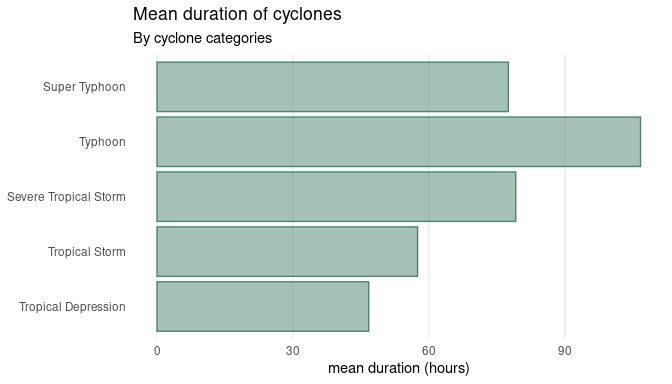

Oceans and seas significantly impact continental weather, with evaporation from the sea surface driving cloud formation and precipitation. Tropical cyclones, warm-core low-pressure systems, form over warm oceans where temperatures exceed 26°C, precipitated by the release of latent heat from condensation. These cyclones, known by various names depending on the region, have organised circulations and develop primarily in tropical and subtropical waters, except in regions with cooler sea surface temperatures and high vertical wind shears. They reach peak intensity over warm tropical waters and weaken upon landfall, often causing extensive damage before dissipating.
The Philippines frequently experiences tropical cyclones (called bagyo - pronounced /baɡˈjo/, [bɐɡˈjo] - in the Filipino language) because of its geographical position. These cyclones typically bring heavy rainfall, leading to widespread flooding, as well as strong winds that cause significant damage to human life, crops, and property. Data on cyclones are collected and curated by the Philippine Atmospheric, Geophysical, and Astronomical Services Administration (PAGASA).
This package contains Philippine tropical cyclones data from 2017 to
2020 in a machine-readable format. It is hoped that this data package
provides an interesting and unique dataset for data exploration and
visualisation as an adjunct to the traditional iris
dataset and to the current palmerpenguins
dataset.
You can install bagyo from CRAN with:
install.packages("bagyo")You can install the development version of bagyo from
the panukatan r-universe
with:
install.packages(
"bagyo",
repos = c('https://panukatan.r-universe.dev', 'https://cloud.r-project.org')
)Once the bagyo package has been installed, the
bagyo dataset can be loaded into R as follows:
library(bagyo)
data(package = "bagyo")
bagyo
#> # A tibble: 86 × 9
#> year category_code category_name name rsmc_name start
#> <dbl> <fct> <fct> <chr> <chr> <dttm>
#> 1 2017 TD Tropical Depression Auri… <NA> 2017-01-07 08:00:00
#> 2 2017 TD Tropical Depression Bisi… <NA> 2017-02-03 14:00:00
#> 3 2017 TD Tropical Depression Cris… <NA> 2017-04-14 14:00:00
#> 4 2017 TS Tropical Storm Dante Muifa 2017-04-26 08:00:00
#> 5 2017 STS Severe Tropical Storm Emong Nanmadol 2017-07-02 02:00:00
#> 6 2017 TD Tropical Depression Fabi… Roke 2017-07-22 02:00:00
#> 7 2017 TY Typhoon Gorio Nesat 2017-07-25 14:00:00
#> 8 2017 TS Tropical Storm Huan… Haitang 2017-07-30 02:00:00
#> 9 2017 STS Severe Tropical Storm Isang Hato 2017-08-20 08:00:00
#> 10 2017 TS Tropical Storm Joli… Pakhar 2017-08-24 14:00:00
#> # ℹ 76 more rows
#> # ℹ 3 more variables: end <dttm>, pressure <int>, speed <int>bagyo is
interesting to summariselibrary(dplyr)
## Get cyclone category mean pressure and speed ----
bagyo |>
group_by(category_name) |>
summarise(
n = n(),
mean_pressure = mean(pressure),
mean_speed = mean(speed)
)
#> # A tibble: 5 × 4
#> category_name n mean_pressure mean_speed
#> <fct> <int> <dbl> <dbl>
#> 1 Tropical Depression 23 996. 39.8
#> 2 Tropical Storm 25 986. 61.6
#> 3 Severe Tropical Storm 15 978. 75
#> 4 Typhoon 21 941. 102.
#> 5 Super Typhoon 2 908. 112.bagyo
is useful in learning how to work with dates## Get cyclone category mean duration (in hours) ----
bagyo |>
mutate(duration = end - start) |>
group_by(category_name) |>
summarise(mean_duration = mean(duration))
#> # A tibble: 5 × 2
#> category_name mean_duration
#> <fct> <drtn>
#> 1 Tropical Depression 46.69565 hours
#> 2 Tropical Storm 57.48000 hours
#> 3 Severe Tropical Storm 79.13333 hours
#> 4 Typhoon 106.66667 hours
#> 5 Super Typhoon 77.50000 hoursbagyo is great to
visualise

If you find the bagyo package useful please cite using
the suggested citation provided by a call to the citation()
function as follows:
citation("bagyo")
#> To cite bagyo in publications use:
#>
#> Ernest Guevarra (2024). _bagyo: Philippine Tropical Cyclones Data_.
#> doi:10.5281/zenodo.10972235
#> <https://doi.org/10.5281/zenodo.10972235>, R package version 0.1.0,
#> <https://panukatan.io/bagyo/>.
#>
#> A BibTeX entry for LaTeX users is
#>
#> @Manual{,
#> title = {bagyo: Philippine Tropical Cyclones Data},
#> author = {{Ernest Guevarra}},
#> year = {2024},
#> note = {R package version 0.1.0},
#> url = {https://panukatan.io/bagyo/},
#> doi = {10.5281/zenodo.10972235},
#> }Feedback, bug reports and feature requests are welcome; file issues or seek support here. If you would like to contribute to the package, please see our contributing guidelines.
This project is released with a Contributor Code of Conduct. By participating in this project you agree to abide by its terms.